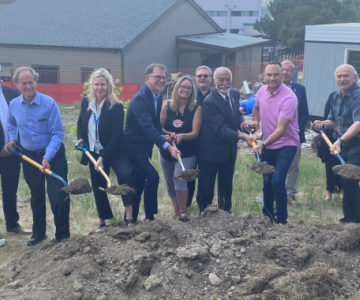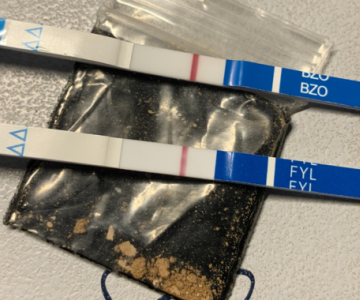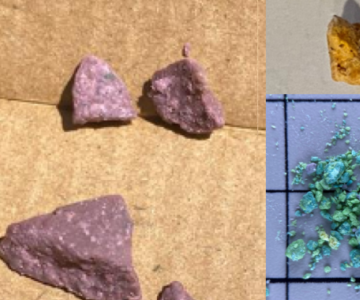Breadcrumb
- Home
- media
Explore Media
News Release
Starting today, expectant parents in the Cariboo-Chilcotin have improved access to maternity care close to home thanks to a new clinic at Cariboo Memorial Hospital.
The maternity care clinic is a partnership between Interior Health (IH) and the Central Interior Rural Division of Family Practice and is now accepting referrals.
"We are thrilled about the opening of the maternity clinic and what it means for expectant parents, babies and families in the community," said Dr. Ivan Scrooby, family medicine maternity physician in Williams Lake. "The dedicated local facility will allow us to see patients without a referral, provide more comprehensive care, and work as a collaborative team to achieve better outcomes for patients."
The maternity clinic will operate Monday to Friday, 8 a.m. to 4 p.m., and will be staffed by four physicians, who will provide full scope maternity care. It will have a centralized referral system and will also be supported by a full-time Licensed Practical Nurse (LPN) and a medical office assistant (MOA).
Maternity patients will be seen with or without a family care provider and the clinic will accept self-referrals. The comprehensive care model will encompass prenatal care, labour and delivery and postpartum support among other services. IH and the Division are also considering ways to expand the services in the clinic to offer other women’s health-care services.
Having a clinical space, centralized referral system and dedicated nursing and administrative support will improve access to pregnant and expecting parents and ensure that they can easily receive the care they need with or without a family care provider. The clinic is also expected to help attract and retain health-care providers by creating a sustainable and supportive practice environment.
“Collaboration between IH and the Division to establish the maternity clinic demonstrates a joint commitment to addressing the challenges faced by rural communities in accessing care close to home,” said Jill Zirnhelt, executive director, Central Interior Rural Division of Family Practice. “Both organizations are dedicated to creating diverse opportunities for providers to attract and retain new health-care professionals in the area.”
Expectant parents without a primary provider can directly book an appointment by calling 250-302-3294. The clinic is located on the main floor of Cariboo Memorial Hospital in room 1207 (behind the main reception desk).
Public Service Announcement
Environment and Climate Change Canada has issued heat warnings for the Thompson/Cariboo/Shuswap, North Okanagan, Central Okanagan, and South Okanagan areas.
The Province has not declared an extreme heat emergency for these regions.
With elevated temperatures, the risk of heat-related illness increases.
The BC Centre of Disease Control provides a broad range of heat-related guidance on its website, including information on the different types of heat alerts, how to prepare for hot temperatures, symptoms of heat-related illnesses, those most at risk during hot weather and ways to stay cool.
Preparing for and responding to hot weather:
If you have air conditioning at home, make sure it is in good working order.
If you do not have air conditioning at home:
Find somewhere you can cool off on hot days. Consider places in your community to spend time indoors such as libraries, community centres, movie theatres or malls. Also, as temperatures may be hotter inside than outside, consider outdoor spaces with lots of shade and running water.
Shut windows and close curtains and blinds during the heat of the day to block the sun and prevent hotter outdoor air from coming inside. Open doors and windows when it is cooler outside to move that cooler air indoors.
Ensure that you have a working fan, but do not rely on fans as your primary means of cooling. Fans can be used to draw cooler late-evening, overnight and early-morning air indoors. Keep track of temperatures in your home using a thermostat or thermometer. Sustained indoor temperatures over 31 C can be dangerous for people who are susceptible to heat.
If your home gets very hot, consider staying with a friend or relative who has air conditioning if possible.
Identify people who may be at high risk for heat-related illness. If possible, help them prepare for heat and plan to check in on them.
Who is most at risk?
It is important to monitor yourself, family members, neighbours and friends during hot weather. Consider developing a check-in system for those who are at high risk of heat-related illness.
Those at highest risk include:
Older adults, especially those over 60
People who live alone
People with pre-existing health conditions such as diabetes, heart disease or respiratory disease
People with mental illnesses such as schizophrenia, depression or anxiety
People with substance use disorders
People with limited mobility and other disabilities
People who are marginally housed
People who work in hot environments
People who are pregnant
Infants and young children
Your health:
Drink plenty of water and other liquids to stay hydrated, even if you are not thirsty.
Spray your body with water, wear a damp shirt, take a cool shower or bath or sit with part of your body in water to cool down.
Take it easy, especially during the hottest hours of the day.
Stay in the shade and use a broad-spectrum sunscreen with SPF 30 or more.
Take immediate action to cool down if you are overheating. Signs of overheating include feeling unwell, headache and dizziness. Overheating can lead to heat exhaustion and heat stroke.
Signs of heat exhaustion include heavy sweating, severe headache, muscle cramps, extreme thirst and dark urine. If you are experiencing these symptoms, you should seek a cooler environment, drink plenty of water, rest and use water to cool your body.
Signs of heat stroke include loss of consciousness, disorientation, confusion, severe nausea or vomiting and very dark urine or no urine. Heat stroke is a medical emergency.
In the event of a medical emergency, call 911. However, it is important to use 911 responsibly to avoid overwhelming the system.
When to call 911:
In cases of heat stroke: loss of consciousness, disorientation, confusion, severe nausea or vomiting or very dark urine or no urine.
In general: when there is chest pain, difficulty breathing, loss of consciousness, severe burns, choking, convulsions that are not stopping, a drowning, a severe allergic reaction, a head injury, signs of a stroke or a major trauma.
If you have a less urgent health issue:
You can call HealthLinkBC at 811 and speak with a nurse or go to an urgent care centre or clinic if you can do so safely. That way, our emergency medical dispatch staff and paramedics will be available for people who need their services the most.
There are also online tools at healthlinkbc.ca, including a “Check Your Symptoms” tool.
- 30 -
Toxic Drug Alert
Please see the attached document to learn more about the look, contamination, and risk associated with the current drug alert.
Public Service Announcement
Environment Canada has issued a heat warning for the Fraser Canyon including the community of Lytton. Daytime high temperatures near 35 degrees Celsius combined with overnight lows near 18 degrees are forecast through Sunday. This is not an extreme heat emergency.
Interior Health is reminding people that elevated temperatures increases the risk of heat-related illness increases.
The BC Centre of Disease Control provides a broad range of heat-related guidance on its website, including information on the different types of heat alerts, how to prepare for hot temperatures, symptoms of heat-related illnesses, those most at risk during hot weather and ways to stay cool.
Preparing for and responding to hot weather:
If you have air conditioning at home, make sure it is in good working order and turn it on.
If you do not have air conditioning at home:
FFind somewhere you can cool off on hot days. Consider places in your community to spend time indoors such as libraries, community centres, movie theatres or malls. Also, as temperatures may be hotter inside than outside, consider outdoor spaces with lots of shade and running water.
Shut windows and close curtains and blinds during the heat of the day to block the sun and prevent hotter outdoor air from coming inside. Open doors and windows when it is cooler outside to move that air indoors.
Ensure that you have a working fan, but do not rely on fans as your primary means of cooling. Fans can be used to draw cooler late-evening, overnight and early-morning air indoors. Keep track of temperatures in your home using a thermostat or thermometer. Sustained indoor temperatures over 31 C can be dangerous for people who are susceptible to heat.
If your home gets very hot, consider staying with a friend or relative who has air conditioning if possible.
Identify people who may be at high risk for heat-related illness. If possible, help them prepare for heat and plan to check in on them.
Who is most at risk?
It is important to monitor yourself, family members, neighbours and friends during hot weather. Consider developing a check-in system for those who are at high risk of heat-related illness.
The most susceptible individuals include:
Older adults, especially those over 60
People who live alone
People with pre-existing health conditions such as diabetes, heart disease or respiratory disease
People with mental illnesses such as schizophrenia, depression or anxiety
People with substance use disorders
People with limited mobility and other disabilities
People who are marginally housed
People who work in hot environments
People who are pregnant
Infants and young children
Your health:
Drink plenty of water and other liquids to stay hydrated, even if you are not thirsty.
Spray your body with water, wear a damp shirt, take a cool shower or bath or sit with part of your body in water to cool down.
Take it easy, especially during the hottest hours of the day.
Stay in the shade and use a broad-spectrum sunscreen with SPF 30 or more.
Take immediate action to cool down if you are overheating. Signs of overheating include feeling unwell, headache and dizziness. Overheating can lead to heat exhaustion and heat stroke.
Signs of heat exhaustion include heavy sweating, severe headache, muscle cramps, extreme thirst and dark urine. If you are experiencing these symptoms, you should seek a cooler environment, drink plenty of water, rest and use water to cool your body.
Signs of heat stroke include loss of consciousness, disorientation, confusion, severe nausea or vomiting and very dark urine or no urine. Heat stroke is a medical emergency.
In the event of a medical emergency, call 911. However, it is important to use 911 responsibly to avoid overwhelming the system.
When to call 911:
In cases of heat stroke: loss of consciousness, disorientation, confusion, severe nausea or vomiting or very dark urine or no urine.
In general: when there is chest pain, difficulty breathing, loss of consciousness, severe burns, choking, convulsions that are not stopping, a drowning, a severe allergic reaction, a head injury, signs of a stroke or a major trauma.
If you have a less urgent health issue:
You can call HealthLinkBC at 811 and speak with a nurse or go to an urgent care centre or clinic if you can do so safely. That way, our emergency medical dispatch staff and paramedics will be available for people who need their services the most.
There are also online tools at ca, including a “Check Your Symptoms” tool.
News Release
B.C.'s largest population health survey, the SPEAK survey, has been extended and will remain open until July 31 to help boost participation.
People living in Interior Health can have a say in shaping the health programs and services in their region by participating in the Survey on Population Experiences, Action, and Knowledge (SPEAK) survey and sharing their experiences over the past few years.
“The SPEAK survey is an important opportunity for people living in our region to have their voice heard around issues such as their social, economic, physical and mental health. It’s particularly important that we hear more from people with unique needs who are usually under-represented, such as racialized populations, people from rural and remote communities, seniors, and those with children,” said Interior Health interim Chief Medical Health Officer Dr. Martin Lavoie.
Together with the BC Centre for Disease Control and health authorities across the province, we launched the third round of SPEAK on April 25. To date in B.C., over 85,000 people have responded and we are hoping to hear from 120,000 people of all backgrounds and from all over the province, particularly from underrepresented groups, where participation levels are lower, such as:
First Nations, Métis and Inuit people
People from racialized communities; including those of Chinese, South and Southeast Asian, Black, Filipino, Latin American, Arab, and more.
People living in rural parts of the province;
Men aged 18 to 34;
People aged 75 and older;
People with no post-secondary education;
People with lower household incomes; and
People with children and young adults in their lives.
The survey asks how people living in B.C. are doing when it comes to their social, economic, physical health, mental health, and overall well-being, so we can better support communities across the province.
The survey takes around 20 minutes to fill out and can be accessed at www.bccdc.ca/SpeakSurvey.
Members of the public are also encouraged to share the survey with their family and loved ones and help them participate as needed.
SPEAK is available in 10 different languages and people’s responses will inform future public health initiatives across the province. By responding to the survey people living in B.C. will let their health authority know what resources are needed to improve health and well-being in their community.
The SPEAK survey is funded by the BCCDC Foundation for Public Health.
The BC Centre for Disease Control, a part of the Provincial Health Services Authority, provides public health leadership through surveillance, detection, treatment, prevention and consultation services. The Centre provides diagnostic and treatment services for people with diseases of public health importance, and analytical and policy support to all levels of government and health authorities. The BCCDC also provides health promotion and prevention services to reduce the burden of chronic disease, preventable injury and environmental health risks. For more, visit www.bccdc.ca or follow us on Twitter @CDCofBC.
News Release
Work is underway for an updated and expanded Cariboo Memorial Hospital, which will improve access to care for people in Williams Lake and surrounding Cariboo-Chilcotin area, including the First Nations of the Secwépemc, Tŝ ilhqot’in and Dãkelh Dené.
“The redevelopment of the Cariboo Memorial Hospital represents a significant investment in the Cariboo-Chilcotin communities’ health and well-being, now and into the future,” said Adrian Dix, Minister of Health. “That is why it is so exciting to be with the community today to celebrate the start of construction that will increase the hospital’s capacity and provide a modern working environment.”
The project includes a three-storey addition, as well as renovations to the existing facility. The redevelopment will add 25 new beds for a total of 53. This includes a new medical/surgical inpatient unit with 36 beds (an increase of 16), a new mental-health and substance-use inpatient unit with eight single-occupancy rooms, a patient-seclusion room and an expanded ambulatory-care and oncology unit with 16 renovated treatment spaces.
There will be a new emergency department with 23 treatment spaces (an increase of 12), two trauma-treatment bays, a seclusion room, an ambulance carport and a separate public entrance.
As well, the new addition will have an expanded maternity and women’s health unit with four single-occupancy rooms for maternity care, two nursery rooms and two women’s health beds in private rooms. The maternity area will allow parents to stay in the same room with their babies until they are ready to go home.
The pharmacy will be expanded, providing additional space for pharmacists and pharmacy technicians. An interfaith sacred space will allow for traditional cultural and healing practices. There will be 71 new parking stalls.
“Our government is taking action to help people who are facing challenges accessing care in rural and remote areas,” said Jennifer Rice, Parliamentary Secretary for Rural Health. “This fully redeveloped hospital will provide expanded access to a state-of-the-art facility for people in Cariboo-Chilcotin to help them get the services they need.”
Construction will happen in two phases. The first phase, which will include the three-storey addition, is expected to finish in 2026. Phase 2 will start after that, will include further renovations and is scheduled to be complete in 2029.
“Beginning construction on the redevelopment of Cariboo Memorial Hospital is a significant milestone. I know the people of Williams Lake and surrounding communities are looking forward to the expansion and the improvements to health services the upgraded hospital will bring,” said Susan Brown, president and CEO, Interior Health. “I am grateful for the contributions from our First Nations partners in the design of the new building. It is such a well-planned space that will benefit not only patients and their families, but also Interior Health staff and physicians.”
The project budget is $366.5 million and will be shared between the Province, Interior Health and the Cariboo Chilcotin Regional Hospital District.
“It’s exciting to see construction start on the Cariboo Memorial Hospital upgrade, which will provide our region, health workers and residents with a modern new facility,” said Al Richmond, chair, Cariboo Chilcotin Regional Hospital District. “I express my thanks to Minister Dix and Interior Health for their continued support and effort to make this project happen.”
Read the original release from BC Gov News
Toxic Drug Alert
Please see the attached document to learn more about the look, contamination, and risk associated with the current drug alert.
Toxic Drug Alert
Please see the attached document to learn more about the look, contamination, and risk associated with the current drug alert.
Toxic Drug Alert
Please see the attached document to learn more about the look, contamination, and risk associated with the current drug alert.
-
Load More
Showing 522 of 1083



